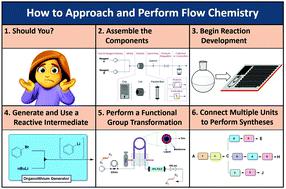当前位置:
X-MOL 学术
›
Chem. Soc. Rev.
›
论文详情
Our official English website, www.x-mol.net, welcomes your
feedback! (Note: you will need to create a separate account there.)
How to approach flow chemistry
Chemical Society Reviews ( IF 40.4 ) Pub Date : 2020-11-03 , DOI: 10.1039/c9cs00832b Mara Guidi 1, 2, 3, 4, 5 , Peter H. Seeberger 1, 2, 3, 4, 5 , Kerry Gilmore 1, 2, 3, 4
Chemical Society Reviews ( IF 40.4 ) Pub Date : 2020-11-03 , DOI: 10.1039/c9cs00832b Mara Guidi 1, 2, 3, 4, 5 , Peter H. Seeberger 1, 2, 3, 4, 5 , Kerry Gilmore 1, 2, 3, 4
Affiliation

|
Flow chemistry is a widely explored technology whose intrinsic features both facilitate and provide reproducible access to a broad range of chemical processes that are otherwise inefficient or problematic. At its core, a flow chemistry module is a stable set of conditions – traditionally thought of as an externally applied means of activation/control (e.g. heat or light) – through which reagents are passed. In an attempt to simplify the teaching and dissemination of this field, we envisioned that the key advantages of the technique, such as reproducibility and the correlation between reaction time and position within the reactor, allow for the redefinition of a flow module to a more synthetically relevant one based on the overall induced effect. We suggest a rethinking of the approach to flow modules, distributing them in two subclasses: transformers and generators, which can be described respectively as a set of conditions for either performing a specific transformation or for generating a reactive intermediate. The chemistry achieved by transformers and generators is (ideally) independent of the substrate introduced, meaning that they must be robust to small adjustments necessary for the adaptation to different starting materials and reagents while ensuring the same chemical outcome. These redefined modules can be used for single-step reactions or in multistep processes, where modules can be connected to each other in reconfigurable combinations to create chemical assembly systems (CAS) targeting compounds and libraries sharing structural cores. With this tutorial review, we provide a guide to the overall approach to flow chemistry, discussing the key parameters for the design of transformers and generators as well as the development of chemical assembly systems.
中文翻译:

如何进行流化学
流动化学是一项经过广泛研究的技术,其内在特征既可以促进并提供可重复使用的化学方法,而这些方法原本就效率低下或存在问题。流动化学模块的核心是一组稳定的条件-传统上被认为是激活/控制的外部应用手段(例如热或光)–试剂通过的地方。为了简化该领域的教学和传播,我们设想该技术的关键优势(例如可重复性以及反应时间和反应器内位置之间的相关性)允许将流量模块重新定义为更合成的基于整体诱发效应的相关研究。我们建议对流动模块的方法进行重新思考,将其分布在两个子类中:变压器和发电机,它们可以分别描述为一组条件,用于执行特定的转换或生成反应性中间体。理想情况下,变压器和发电机产生的化学反应与所引入的基材无关,这意味着它们必须在适应相同的起始原料和试剂的同时,必须对微小的调整具有鲁棒性,同时还要确保相同的化学结果。这些重新定义的模块可用于单步反应或多步过程,其中模块可按可重新配置的组合相互连接,以创建针对化合物和共享结构核心的库的化学组装系统(CAS)。通过本教程的复习,我们为流化学的整体方法提供了指南,讨论了变压器和发电机设计以及化学装配系统开发的关键参数。其中模块可以以可重新配置的组合方式彼此连接,以创建针对化合物和共享结构核心的库的化学组装系统(CAS)。通过本教程的复习,我们为流化学的整体方法提供了指南,讨论了变压器和发电机设计以及化学装配系统开发的关键参数。其中模块可以以可重新配置的组合方式彼此连接,以创建针对化合物和共享结构核心的库的化学组装系统(CAS)。通过本教程的复习,我们为流化学的整体方法提供了指南,讨论了变压器和发电机设计以及化学装配系统开发的关键参数。
更新日期:2020-11-03
中文翻译:

如何进行流化学
流动化学是一项经过广泛研究的技术,其内在特征既可以促进并提供可重复使用的化学方法,而这些方法原本就效率低下或存在问题。流动化学模块的核心是一组稳定的条件-传统上被认为是激活/控制的外部应用手段(例如热或光)–试剂通过的地方。为了简化该领域的教学和传播,我们设想该技术的关键优势(例如可重复性以及反应时间和反应器内位置之间的相关性)允许将流量模块重新定义为更合成的基于整体诱发效应的相关研究。我们建议对流动模块的方法进行重新思考,将其分布在两个子类中:变压器和发电机,它们可以分别描述为一组条件,用于执行特定的转换或生成反应性中间体。理想情况下,变压器和发电机产生的化学反应与所引入的基材无关,这意味着它们必须在适应相同的起始原料和试剂的同时,必须对微小的调整具有鲁棒性,同时还要确保相同的化学结果。这些重新定义的模块可用于单步反应或多步过程,其中模块可按可重新配置的组合相互连接,以创建针对化合物和共享结构核心的库的化学组装系统(CAS)。通过本教程的复习,我们为流化学的整体方法提供了指南,讨论了变压器和发电机设计以及化学装配系统开发的关键参数。其中模块可以以可重新配置的组合方式彼此连接,以创建针对化合物和共享结构核心的库的化学组装系统(CAS)。通过本教程的复习,我们为流化学的整体方法提供了指南,讨论了变压器和发电机设计以及化学装配系统开发的关键参数。其中模块可以以可重新配置的组合方式彼此连接,以创建针对化合物和共享结构核心的库的化学组装系统(CAS)。通过本教程的复习,我们为流化学的整体方法提供了指南,讨论了变压器和发电机设计以及化学装配系统开发的关键参数。











































 京公网安备 11010802027423号
京公网安备 11010802027423号